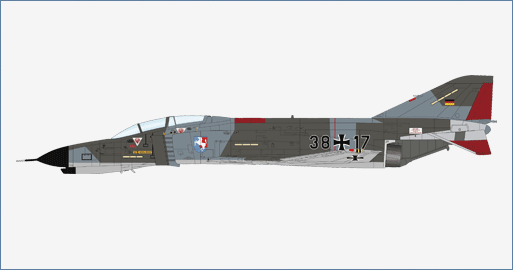Air Power Series>1:72 die-cast display model>F-4>HA19098
F-4F Phantom II 38+17, JaboG "Westfalen", 1981

General Background
One of the most famous and easily recognized fighter aircraft of the post-WWII era was the McDonnell F-4 Phantom II. This aircraft was developed as a private venture by the aircraft company but was soon ordered by the USN as a carrier-based attack aircraft. Its first flight took place on May 27, 1958 and it entered active service in December 1960. It wasn’t long after the F-4B appeared that a fly-off was set up with USAF front-line fighters. It was no contest, the F-4 performed so well that the USAF ordered their own variant, the F-4C. As time went on, the F-4 evolved into well over a dozen variants.
Specifications :
| Manufacturer: | McDonnell-Douglas |
| Type: | Fighter/Ground Attack |
| Crew: | 2 |
| Dimensions | |
| Length: | 19.40 m |
| Height: | 5.01 m |
| Wingspan: | 11.70m |
| Weight | |
| Empty: | 21,950 kg. |
| Max T/O weight: | 27,300 kg |
| Powerplant : | 2 X J79-MTU-17A engines were built under license from General Electric by Motoren-und-Turbinenen-Union Munchen GmBH. |
| Performance | |
| Thrust: | 5,308 kg (8,120 kg with A/B) |
| Max speed: | Mach 2.23 @ 12,500 m |
| Initial Climb Rate: | 41,000 ft/min (210 m/s) |
| Armament: | 4 x AIM-120A AMRAMM air-to-air Missiles The F-4F originally lacked the capability of carrying nuclear weapons and it could not carry or launch certain air-to-ground missiles such as the Maverick, Shrike, or Walleye. The design that finally emerged was 3300 pounds lighter than the stock F-4E. The number 7 fuselage fuel tank was removed and all Sparrow equipment was eliminated. The AN/APQ-120 radar was simplified, with no beacon search or constant wave illuminator being provided for Sparrow or Falcon missile launches. Although no in-flight re-fuelling receptacle was initially fitted, the internal plumbing needed for midair re-fuelling was installed at the factory. |

